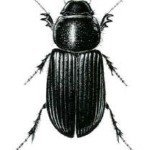 In the deep dark sea, bioluminescence is the name of game. Its central role is unequivocal for many organisms. Do different sexes of species display dimorphism with respect to bioluminescence? Does it have a role in the dirty deeds that occur in the dark? The following is an illuminating
In the deep dark sea, bioluminescence is the name of game. Its central role is unequivocal for many organisms. Do different sexes of species display dimorphism with respect to bioluminescence? Does it have a role in the dirty deeds that occur in the dark? The following is an illuminating dirty laundry list of all sex and lights in the deep.
- The most obvious would be to make the business parts light up. Ovaries and eggs of asteroids, ophiuroids, and meduase can bioluminescence. Surprisingly, no cases of glowing testes are known. So males may have to resort to other tactics. However, this is all unlikely to be sexually meaningful as these organisms cannot see it.
- Distinction between the sexes may also arise when the number of bioluminescent glands between males and females differs. Males of the copepod, Oncaea conifera, are not only smaller than females but as expected contain fewer glands.
- So I see by your distribution of photophores you’re a female…wanna come to my part of the bathypelagic and get your photophores near mine? The pattern of photophores may also differ between the sexes. Among midwater shrimps of the genus Sergestes and Nematobrachion, both photophore number and arrangement vary along the ventral surface of the abdomen. In Nematobranchion, males go one step further with one, and in some cases 2, enlarged photophore(s). But given the variability in photophore size, distribution, and number among individuals despite sex, the poor visual acuity of the group, and that the location of the counter-illumination photophores is only observable to those directly below, differences are probably not flirtatious.
- Let us not forget our cephalopod brethren. Males of the squid Lycoteuthis diadema differ in both having more photophores across the mantle and on arms II and III. This sexual dimorphism was so stark that males were once considered both a separate species and genus. In the squid Selenoteuthis scintillans, males have a larger photophore at the end of the mantle and the presence of arm tip photophores. But females are representin’ as well. In many of the Cranchiids, females develop a large, and structurally unique, arm tip photophore. In octopus, Japetella females possess a photophore that degenerates after spawning.
- In the anglerfishes, females take the prize. Unlike our species where males are metaphorically and functionally parasitic, male anglerfishes are dwarfed and actually parasitic. The bioluminescent head lure that makes anglerfishes a favorite of all is confined to females in all but one case. So are these differences between the sexes important for sexual communication, a lighted com-hither? Doesn’t fair well for anglers as the role of the lure is for food attraction, a function only needed by the females.
- Dragonfishes, again with the females often larger, also display sexual dimorphism in bioluminescent structures among most species. The males have enlarged photophores behind the eye. Of course they lack teeth, a barbell, and pelvic fins so this seems little consolation. However for dragonfishes the odds are better for bioluminescence being sexually meaningful. Perhaps, the size of the postorbital photophore is an indication of the male’s fitness.
- The laternfishes display the best evidence of sexual dimorphism, with variation in size and presence of photophores at the base of the tail common. Given the “complexity and variety of sexual dimorphism in lanternfish caudal photophores” there is “strong circumstantial evidence for their involvement in sexual signaling.” (Herring 2007)
- Bioluminescent secretions. As that roles around your head, I will clarify. In marine worms, females can secrete a bioluminescent fluid at the surface that attracts males. They thank the ladies by circling them and secreting their own bioluminescent fluid.




This post (and figures) made possible by the wonderful review of Peter Herring, Sex with the lights on? A review of bioluminescent sexual dimorphism in the sea published in JMBA (2007). More on bioluminescence at DSN.






So if many of these species can’t see their own bioluminescence, does it still serve some purpose, or is it an evolutionary artifact where there was no selector to eliminate bioluminescence?
Keep in mind that they don’t necessarily need to see it for it to be functional. In predator avoidance or to attract prey it would only need to be observable to their whatever they are trying to attract or avoid.
Last night on the Discovery Channel, ‘Deep Blue’ from the ‘Blue Planet’ series was on for two hours. There was several scenes on the bioluminescence of the deep with both fish and inverts showcased. I then got to explain to my husband the reasons for all the blinking lights thanks to this article and my past experience with deep sea research.
Thanks a lot for this …
illuminating post!
:-)
I’ll try to get me a copy of the original: it’s really fascinating!